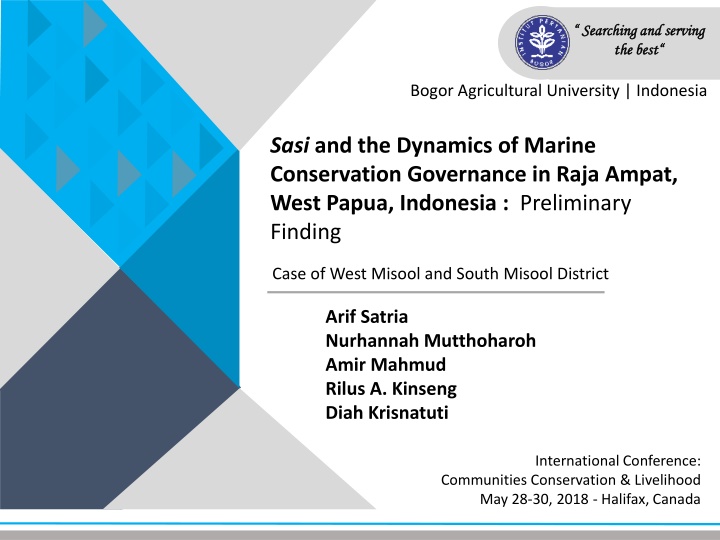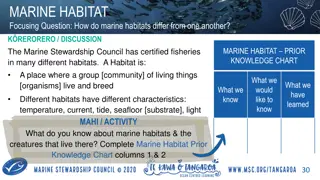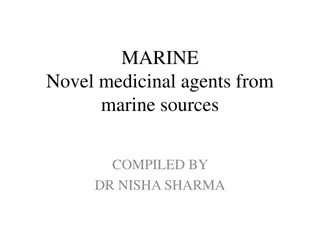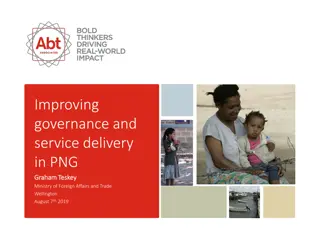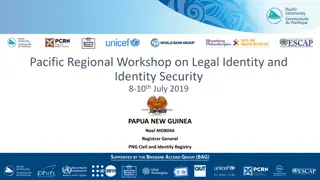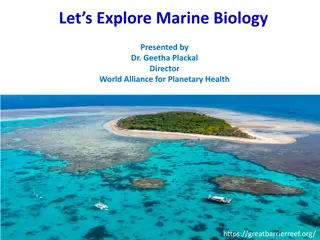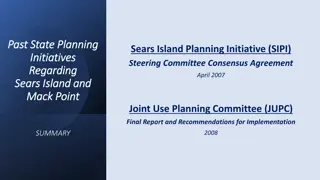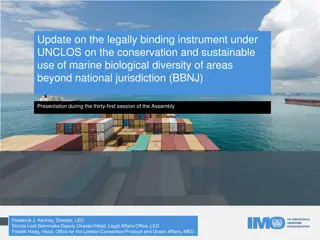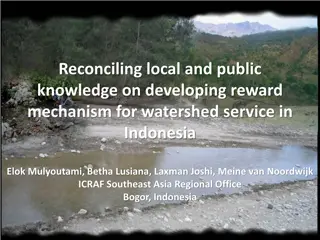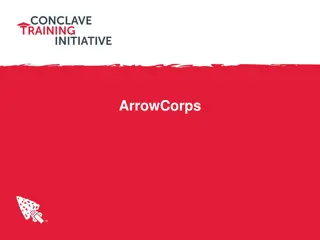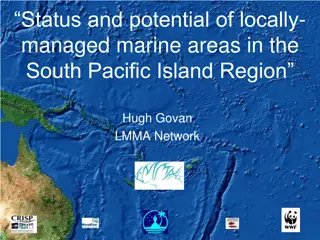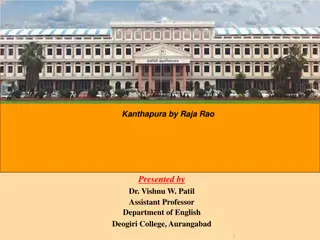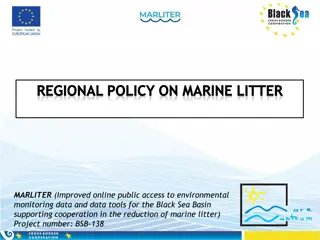Marine Conservation Governance in Raja Ampat, West Papua, Indonesia
Explore the dynamics of marine conservation governance in Raja Ampat, West Papua, Indonesia, with a focus on Sasi practices and the preliminary findings in the West Misool and South Misool districts. Discover the potential resources in Raja Ampat and the various types of marine conservation areas in Indonesia. Learn about the policy level modern conservation regimes shaping marine conservation efforts in the region.
Download Presentation

Please find below an Image/Link to download the presentation.
The content on the website is provided AS IS for your information and personal use only. It may not be sold, licensed, or shared on other websites without obtaining consent from the author.If you encounter any issues during the download, it is possible that the publisher has removed the file from their server.
You are allowed to download the files provided on this website for personal or commercial use, subject to the condition that they are used lawfully. All files are the property of their respective owners.
The content on the website is provided AS IS for your information and personal use only. It may not be sold, licensed, or shared on other websites without obtaining consent from the author.
E N D
Presentation Transcript
Searching and serving Searching and serving the best the best Bogor Agricultural University | Indonesia Sasi and the Dynamics of Marine Conservation Governance in Raja Ampat, West Papua, Indonesia : Preliminary Finding Case of West Misool and South Misool District Arif Satria Nurhannah Mutthoharoh Amir Mahmud Rilus A. Kinseng Diah Krisnatuti International Conference: Communities Conservation & Livelihood May 28-30, 2018 - Halifax, Canada
Raja Ampat Regency, West Papua, Indonesia has many potential resources pic: google.com
OUTLINE Introduction 1 2 Research Location Marine Conservation in Raja Ampat 3 Sasi 4 Discussion 5 International Conference: Communities Conservation & Livelihood | May 28-30, 2018 - Halifax, Canada
INTRODUCTION Indonesia's coral reefs covers 51.020 km2 (50% of the total area of the world's coral reefs) Only 6% of Indonesia's coral reefs are classified as "excellent , and 30% condition "very poor Marine conservation areas in Indonesia are increase : 2012 : 14,661,696 ha 2014 : 16,065,363 ha * (1,403,667 ha managed by Regional Water Conservation Area community based) Source: Tun et. Al (2004); MMAF (2015) International Conference: Communities Conservation & Livelihood | May 28-30, 2018 - Halifax, Canada
INTRODUCTION : Types of Conservation Conservation Technocratic/ Modern Populist/ Communitarian Customary base Revitalized- customary Non- Centralistic Decentralistic customary Sasi National Park District Conservation Area/KKPD Sasi, Awiq- awiq
Types of Marine Conservation Figure 1. Types of Marine Conservation Area in Indonesia 0% 0% 18% 4% 2% 1% 61% 14% Marine National Park Marine Ecotourism Park Marine Sanctuary Marine Natural Preservation Distric Marine Conservation Area Initiate Distric Marine Conservation Area Marine Protected Area/Marine Sanctuary for Mangrove Fish Sanctuary
Policy Level Marine Modern Conservation Regimes : Conservation Regimes Law of 5/1990 Law of 31/2004 & 45/2009 Fisheries Regime Law of 27/2007 & 1/2014 Coastal Management Forestry Regime Biodiversity conservation Coastal and small island management Fisheries management Coastal and Small Island Conservation area Marine Conservation Area Water Conservation Area Ministry of Marine Affairs and Fisheries Ministry of Marine Affairs and Fisheries Ministry of Forestry
Modern Marine Conservation Regimes Ministry of Forestry Regime Ministry of Marine Affairs & Fisheries Regime Marine National Park (Taman Nasional Laut) Marine Nature Park (Taman Wisata Alam Laut) Marine Wildlife Sanctuary (Suaka Margasatwa Laut) Marine Reserve (Cagar Alam Laut) Centralization system Aquatic National Park (Taman Nasional Perairan) Natural Water Sanctuary (Suaka Alam Perairan) Aquatic Park (Taman Wisata Perairan) Regional Water Conservation Area (Kawasan Konservasi Perairan Daerah (KKPD) decentralization system Source: MMAF 2012; Satria et al 2017 International Conference: Communities Conservation & Livelihood | May 28-30, 2018 - Halifax, Canada
PROFILE West Papua
PROFILE Misool Misool Islands is divided into 4 Districts: - South Misool (Fafanlap Village Case) - West Misool West (Case Kampung Lilinta & Kapatcol) - East Misool - North Misool International Conference: Communities Conservation & Livelihood | May 28-30, 2018 - Halifax, Canada
Raja Ampat established as District/Regional Marine Conservation Area
DISTRICT MARINE CONSERVATION AREA Areas Zoning System District and Villages (Misool Island) South Misool Disrict: Harapan Jaya, Yellu, Dabatan, Kayarepop & Fafanlap. West Misool District: kampung Kapatcool, Lilinta, Biga, Gamta & Magei. East Misool District: Usaha Jaya, Tomolol, & Folley 343.200 ha (Perbup Raja Ampat No. 05/2009) The core zone Limited utilization zones for food security and tourism, The utilization zones are limited to sustainable fisheries and aquaculture, Other zones for traditional community use and Sasi, Other zones for other uses, Other zones for the ship line International Conference: Communities Conservation & Livelihood | May 28-30, 2018 - Halifax, Canada
DISTRICT MARINE CONSERVATION AREA Historical Review Initiation by NGOs: Conservation International (CI) dan The Nature Conservancy (TNC) 2001 Tomolol Declaration : agreement between customary leaders, government leaders, religious leaders and NGOs 2003 Extension of Raja Ampat District 2005 Formal establishment of marine conservation management (Peraturan Bupati Raja Ampat No.66 Tahun 2007 tentang Kawasan Konservasi Laut Daerah Raja Ampat) 2007 International Conference: Communities Conservation & Livelihood | May 28-30, 2018 - Halifax, Canada
SASI: COMMUNITY CONSERVATION IN RAJA AMPAT Meaning: Sasi literally means "prohibition". Closed Session: The public should only pass in the territorial waters and not allowed to take marine life especially lola, lobsters, and sea cucumbers. Open Session: Communities are allowed to pass and take marine resources in the waters. International Conference: Communities Conservation & Livelihood | May 28-30, 2018 - Halifax, Canada
SASI: COMMUNITY CONSERVATION IN RAJA AMPAT Type of Sasi Aspect Customary Sasi Kampong Sasi (Sasi Adat) (Sasi Kampung) Initiation Hereditary customary TNC Areas All the waters in a village area Some areas in a kampong are determined based on biological studies and community consultations Deliberation of society and supported by biological study from TNC Rules of open- close session Following the turn of the season from generation to generation Product utilization Individual needs Community needs Type of biota Lola, lobsters, & sea cucumbers Lola, lobsters, & sea cucumbers International Conference: Communities Conservation & Livelihood | May 28-30, 2018 - Halifax, Canada
SASI: COMMUNITY CONSERVATION IN RAJA AMPAT Why practicing Sasi? What is the benefit of Sasi? 78 72 72 31.7 39 67.1 65.9 2.4 a b c d e 23.2 3.7 Preserving marine resources Complying customary law Fear of magical powers Fear of curse (sickness / death) Increasing the income a : coral reefs are getting better b : increasing fish stock c : equality of marine product d : increasing the income e : increasing the community solidarity International Conference: Communities Conservation & Livelihood | May 28-30, 2018 - Halifax, Canada
SASI: COMMUNITY CONSERVATION IN RAJA AMPAT Sasi for Women (Kampung Kapatcol) Authority : Customary leaders, religious leaders, village heads, women leaders. Sanctions: Religious sanctions in the form of a sick curse and / or up to death for offenders. Monitoring & Evaluation: Monitoring the development of marine biota including sasi zones supported by TNC. International Conference: Communities Conservation & Livelihood | May 28-30, 2018 - Halifax, Canada
SASI: COMMUNITY CONSERVATION IN RAJA AMPAT Sasi for Women (Kampung Kapatcol) The utilization of sasi products 2015 : renovation and maintenance of the building, 2016 : to purchase of Women's Church Guild uniforms. 2017 : scholarship for the Kapatcol residents who are enrolled in the police institute International Conference: Communities Conservation & Livelihood | May 28-30, 2018 - Halifax, Canada
DISCUSSION External Challenges Internal Challenges Issue of funding and the capacity of human resources, monitoring and evaluation. Issue of authority transfer from district to Province. The actor interests on marine resources become more complex regarding to the increase of marine tourism activities coastal grabbing ? Conflicts over land and coastal territorial claims : inter-clan conflict. Institutional sustainability : problem of regeneration International Conference: Communities Conservation & Livelihood | May 28-30, 2018 - Halifax, Canada
CONCLUSION The Role of NGOs linking social capital Good practice of harmonization between modern and communitarian conservation Sasi Ibu Gender perspective is applied Market intervention to petuanan system tourism industry : embryo of tenurial conflict International Conference: Communities Conservation & Livelihood | May 28-30, 2018 - Halifax, Canada
THANK YOU International Conference: Communities Conservation & Livelihood | May 28-30, 2018 - Halifax, Canada
Acknowledgement : CCRN Project Ministry of Higher Education and Research Rici Pranata Caca Soraya Pemkab Raja Ampat TNC and CI
